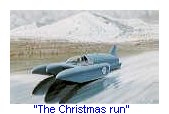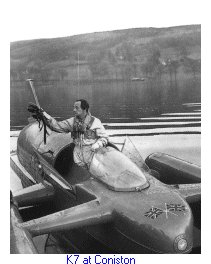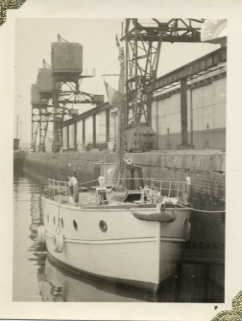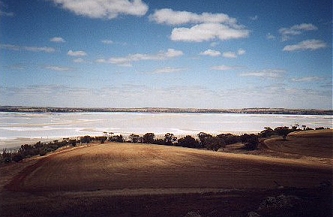

 |  |
After his fathers death in 1948 Donald purchased his K4 for a nominal fee, due to a clause in his will. The boat was set up in a jet configuration, after Sir Malcolm had it converted from its original propeller configuration in an unsuccessful attempt on the waterspeed record at Coniston in 1947.
Donald wanted to run the boat in this jet configuration, but due to his inexperience and his experienced fathers struggles with it, Major Halford of deHavilland was reluctant to let Donald use the jet engine and asked for it back! This also came as a relief to Leo Villa for he too was more comfortable for Donald to use it in propeller form. Vospers were instructed to deconvert it back to the propeller configuration, which they did and returned it back to Donald to install the Rolls Royce engine.
With the engine installed K4 took to the water on the 10th of August for Donald to have his first taste of her. He made four runs primarily to allow him to get comfortable with the boat, he settled in nicely averaging around 80mph for the four runs. Further subsequent runs took place that week, giving Donald a few hairy moments!
On the 19th Donald made an attempt on the record. It was not without drama however. On the first south run a hatch cover came away and put the boat into a slide, on the return run north oil from the gearbox spilled into the cockpit and covered the windscreen and Donald’s legs. Donald though did not let up. On returning to shore, Donald’s wife at the time, Daphne was informed by the timekeepers that Donald had broken his fathers record. Donald, though delighted called for a minutes silence in honour of his father. The jubilation though was short lived, half an hour later the timekeepers informed the team that there had been an error in their calculations and he was in fact 2mph under the record. After the run they discovered that the propshaft had been badly scored, as well as a nearly seized gearbox.
The boat was taken back to Surrey for repair. Donald then suggested that another seat be fitted for Leo Villa. This was so that Leo could look at the instruments for him and also to monitor the behaviour of the boat, while Donald concentrated on driving. The cockpit was placed on the starboard side replacing one of the fuel tanks. During some trials in 1950 the team heard that the water speed record had been broken by a large margin by Stanley Sayers in his boat Slo-Mo-Shun. It had been raised from 141.74 to 160.32mph. This caused concern, as the team were lead to believe that K4 may flip on its back if speeds exceeded 150mph! However with the installation of a newly designed propeller, they prepared to try again. The weather, not for the last time in Donalds speed breaking career caused delays until 7th August, when they managed to go out onto the water. During this trial the water intake for cooling the engine lifted above the water and thus starved the boat of the water it needed to cool the engine. The engine overheated and the cylinder heads damaged. The run though provided an important realisation. Leo had noticed what he initially thought was the bow dipping, Donald noticed this too. It then became apparent that it was in fact the stern rising. This is what caused the intake to lift clear of the water. Reid Railton then informed the team that Stanley Sayers boat used a special propeller that enabled the boat to lift out of the water and "ride" on the propeller. This was the effect that was being felt by Donald and Leo. Reid Railton watched the boat on the water and confirmed that this is what was happening to K4. The team then fitted a new scoop fitted more forward on the boat ready for further trials. The trials late in the year were successful in resolving the cooling problems, but Donald had bigger ideas.
Donald wanted to convert the boat to a full-blown prop rider. Lewis and Ken Norris undertook the design for the conversion. The engine was moved forward to alter the centre of gravity, and Donalds seat was relocated on the port side. A new propeller was also needed. During this build Donald was invited to enter the Oltranza Cup races in Italy. The race took part on Lake Garda. This was four laps over a 5-mile triangular course; with the winner winning the Grand Prix for the fastest overall speed and the Oltranza cup going to the boat that set the fastest time over two consecutive laps. The boat had a tendency to corkscrew and even the fitting of a new propeller failed to help. They eventually settled on an old propeller of Malcolm’s, the boat still corkscrewed but to a lesser extent. The race took place on the 10th of June after being delayed because of bad weather. As they were about to start the race the engine failed to start, they then decided to change the spark plugs, all 24 of them. This now left them well behind in the race with now chance of winning the Grand Prix; they could however still win the Oltranza cup. Donald gave Leo the ride of his life as he flew around the course; the boat was taking a bit of a pounding (all the instruments were shaken to bits apart from the rev counter!). Donald had lost track of how many laps they had completed and tried to get the attention of Leo to find out. He got Leos attention alright, along with some choice words of what he thought of Donald and the cup! They had won the Oltranza cup, and by a large margin. This gave Donald some true recognition for his skills as a driver.
On their return from Italy, Lewis and Ken Norris looked into the problems of the corkscrewing encountered with the boat. The came up with three propellers that they hoped would cure the problem. The took the boat out on Coniston in September 1951, but the corkscrewing still continued, they then tried putting ballast in different parts of the boat, again without success. Reid Railton the suggested they tried increasing the angle of the front plaining shoes. They took her out on the water and gave her a run. At low speed the boat tramped from side to side, but when the speed increased the tramping stopped and the boat ran smoother than ever, with no corkscrewing. Delighted Donald decided to turn around and give it a bit more, again after tramping the boat stabilised and was flying. Then all of a sudden they hit a submerged object, the boat started to slide everywhere. When it came to a standstill they noticed water coming in, the boat was sinking. The boat sank before they could get to the shore, albeit in shallow water. The boat was a write off, salvageable parts were removed, and the carcass was then burnt. Donald was left to think over his next move.

In 1952 Stanley Sayers increased the water speed record to 178.49mph. John Cobb was to challenge the record in his boat "Crusader". Donald considered building a boat to enter the Harmsworth trophy, this was suggested to him by Bill Coley. The Americans had held the trophy for a number of years and it could provide Donald with the challenge he desired. He asked Lewis and Ken Norris to design the new boat. Unlike the K4 the K7 was to have a metal hull, capable of withstanding more stresses than a wooden hull. The design was different to Slo-Mo-Shun, which had a wide surface with planning points each side and at the rear. (This made for a very close to unstable boat, with the front of the boat tending to rise the faster the boat went). The K7 design was similar to John Cobbs in that "outriggers" were used in conjunction with a central planning surface, which helped move the centre of pressure behind the centre of gravity (The main difference between the two boats layout was that the outriggers on K7 were at the front, whereas with "Crusader" they were at the rear. Early on the boat was designed to be fitted with a propeller, rather than the jet engine. To comply with Harmsworth trophy regulations, two seats were built into the design side by side in front of the engine. Donald still preferred the jet engine route though and also had tests done on a model by Saunders-Roe.
The boat was taken to Glenridding, the teams HQ for the trials on Ullswater. The boat was "launched" by Donald's wife at the time, Dorothy. The boat was then lowered down the slipway in her cradle and eventually released onto the water. What was hoped to be an encouraging but tempered first run ended in frustration. The boat was completely new to the team and Donald, however Donald was determined to try a trial run as soon as the boat was in the water. Donald fired up the jet engine and proceeded to accelerate down the water, however as soon as the boat accelerated it dipped forwards and water sprayed into the air intakes and "flamed out" the engine. The engine fired a number of times (automatically as it happened, as a faulty solenoid meant the starter was permanently engaged!), but the same problem occurred. The boat was bought in, it appeared that the trim of the boat was out. Over the next couple of weeks various remedies were tried. The boat was fitted with buoyancy tanks which were supposed to be filled with water to weigh the boat down, however these failed to hold the water, weights were eventually added. The front sponsons were adjustable, and they were moved forward, while the engine was moved back. Things were also improved by removing part of the stern to reduce the buoyancy at the rear. Although these improved the boats trim, it still wouldn't rise up and plane. The front spars, that connected the sponsons to the hull, were found to be too low, this meant that when trying to get the boat to rise, a suction effect caused by the spars resisted the boat rising. After consulting Ken and Lewis Norris the team then fitted deflector panels in front of the intakes, between the sponsons, this helped to stop the spray of water into the intakes and also had the added effect of increasing lift. On the 14th March the newly modified boat went onto the water again, this time she lifted up onto her planing points and to the delight of the team planed properly for the first time. Donald was under instructions not to exceed 150mph as the modifications were pretty much improvised. He actually took the boat up to around 130mph. Back on shore Donald had described how it felt as no sooner had the boat come up ready to plane, than it seemed to want to dip again, before she rose up fully. This did not seem apparent to the observers and what Donald suggested next gave Leo Villa a sleepless night! Donald suggested that Leo take the boat out to see if he experienced the same effect. Leo was just as worried for the boat as himself! however he was able to confirm the same effect. The team then headed south after satisfying themselves that the boat, when up and planing was capable of very fast runs.
Whilst the boat planed comfortably at around the 150mph area, Lewis and Ken Norris decided they needed to test model to determine the effect of the improvised deflectors. Imperial college provided a wind tunnel for the model boat to be tested in. Meanwhile Donald, Leo and Maury Parfitt decide to run some tests on a model of their own. A fishing line was attached to the boat at a point designed to reflect the angle the boat would have if powered by the thrust of the jet engine. This line was then reeled in on a small motor. Donald would film the model with a cine camera; the team would then develop and review the film. They would then make modifications to the model to see if there were any improvements to be gained. All the while information was passed between Lewis and Ken Norris's wind tunnel results and the rest of the team's findings. They concluded that the baffles between the spars should not be used, as the lift they gave would cause the boat to flip at speeds of around 200mph. The solution Lewis and Ken Norris came to was to raise the front spars higher above the water. Tests carried out with the model on the water confirmed this to work.
More to come....
On 29th September John Cobb was killed whilst attempting to break the record at Loch Ness in Scotland. Donald's attentions now moved from building a boat for the Harmsworth trophy to the water speed record.
Donald sold his half share in a company he owned, and set about the task of putting the project together. The jet configuration model tests encouraged Donald to try to secure a jet engine. It would enable Donald to put the record out of reach of the propeller driven Slo-Mo-Shun. Donald approached Air Commodore F.R. Banks at the Ministry of supply. He suggested using a Metropolitan Vickers Beryl engine. This engine produced 3750lbs of thrust, which was plenty of power to obtain the record. Two of the engines were obtained from the ministry of supply and as a bonus Metropolitan Vickers agreed to overhaul them.
Saunders Roe, who were going to make the boat, decided to drop out, they were only interested in propeller driven craft. They would still provide any technical advice and tank testing facilities though. Castrol who had sponsored Sir Malcolm, decided against sponsoring Donald, this was a huge setback. After John Cobb's tragic crash persuading large sponsors to invest in a seemingly dangerous pursuit was not the easiest of tasks.
Despite these setbacks plenty of commercial interest was shown initially by companies, who offered their services or small amounts of money. Accles and Pollock offered to make the main frame, this was made of square section high tensile chrome-molybdendum. A subsidiary of the Lancashire Aircraft corporation, Samlesbury Engineering offered to construct the hull after Donald had asked the Sir Wavell Wakefield, who was a director in the company. This was only after some lengthy talks and meetings. One of the clauses of building the boat was that it was to run at Ullswater, where Sir Wavell owned the pleasure steamers. Donald did have concerns because the water narrowed at the eastern end, however on the whole was happy. Samlesbury were mainly concerned with coachbuilding at the time but they also built aircraft wings, however building an all metal hulled jet boat represented a groundbreaking challenge. The boats frame was covered in aluminium sections, which were made watertight by sealing and overlapping. After fitting out, Bluebird K7 was handed over to Donald Campbell on the 26th November 1954, after being unveiled by Lady Wakefield. The boat was not quite finished at this time as leaks were found during tests that had to be rectified after the ceremony. The boat had still personally cost Donald around £18,000 of his own money, which he could only finance by remortgaging his home.
K7 BUILD ACKNOWLEDGMENTS
As copied from the Samlesbury Engineering launch booklet. I have tried to put links to the current incarnation of the companies listed, please let me know if you know any more, or indeed if any are inaccurate!
Accles & Pollock Ltd
Adams & Adams Ltd.
Aviation Developments Ltd.
Bell's Asbestos and Engineering Ltd.
Birmetals Ltd.
Bloctube Controls Ltd.
B.O. Morris Ltd.
Burman & Sons Ltd.
C. C. Wakefield & Co.Ltd.
College of Aeronautics
Douglas Holt Ltd.
Dunlop Rubber Co. Ltd
Dzus Fasteners (Europe) Ltd.
G.Q. Parachute Co. Ltd.
Graviner Mfg. Co. Ltd.
Henderson Safety Tank Co Ltd
Imperial College of Science and Technology
Joseph Lucas (Electrical) Ltd.
Joseph Lucas (Gas Turbine Eqpt. Ltd.)
Kodak Ltd
Laystall Engineering Co. Ltd
LleweIlyn Ryland Ltd
Lombard Banking Ltd.
Louis Newmark Ltd
Ministry of Supply,
Admiralty Experiment Work
Shell-Mex & B.P. Ltd
Siebe, Gorman & Co. Ltd
Simmonds Aerocessories Ltd
Smith's Industrial Instruments Ltd.
Tecalemit Ltd.
Thos. Firth & John Brown Ltd
Triplex Safety Class Co. Ltd
Ultra Electric Ltd
Vickers-Armstrong Ltd (Barrow)
Wildt & Co Ltd
The team set about the modifications, raising the spars 10 inches as well as other smaller modifications, including rounding the nose. Other weight saving measures were taken, the onboard starter was removed, and some special automatic water deflectors were taken off also. These modifications took around two months to complete. Once done Bluebird needed a few more minor adjustments after tests in late June and early July.
On July 23rd 1955 Donald prepared for an attempt on the record. Instead of a measured mile, Donald preferred the Kilometre (either sufficed for the official record), this was because he was worried by a narrow part of the lake he would have to pass through at speed if he was to be measured over the mile. Despite a painful back Donald eased himself into the boat, and prepared for his run.

Suzette owns boat that she was told once owned by Donald Campbell. Now called Memory, it was previously called "Viadoro" and before that "Daphne". Can anyone confirm this from the photographs below? If so please email me at deanali@lineone.net
 |  |
The following pictures are of the Memorial on Pussycat Hill Lake Dumbleyung have been sent in by Warren Matthews who was one of the offical timekeepers at Dumbleyung in 1964. He is hoping with others to establish a museum at Dumbleyung, he writes "There are a number of different thoughts on project.
One group wants a grant of $770,000 from Government and have a combined Museum/Display Hall with Aboriginal Heritage etc- others want a specific Campbell Museum." They have already had a display He also notes on the current state of the Lake "Unfortunately Lake Dumbleyung has
barely enough water to play model boats let alone put K7 back in. A flood
in 1982 changed lake completely as you will see from photo".
The memorial consists of a large 8' high vertical slab of granite in the shape of Western Australia. In the gound alongside is a bronze plaque showing the outline of the lake and K7 in relief. At 3.43 each year on December the 31st the sun shines through a small hole on the slab and onto the boat!
 |  |
| The Memorial | Plaque on the floor |
 |
A very dry Lake Dumbleyung, November 2001 |